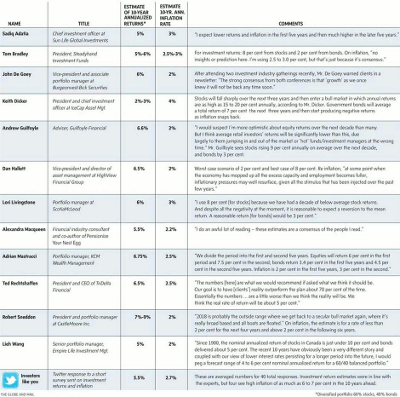Your portfolio may be built around expected levels of return that are unlikely for the foreseeable future, writes Rob Carrick of The Globe and Mail, who asked a number of experts for their current long-term return projections.
Let’s get real about investment returns.
Advisor John De Goey did just that recently, and he’s now using a lower long-term rate of return when he builds portfolios for clients.
De Goey has long been using Andex charts, a recognized source owned by Morningstar, to develop his return expectations. Going back to 1950, he said, the charts showed average annual stock-market returns of 10.3% in Canada over the past 60 years, and 11% annual gains in the US market.
Then De Goey attended a pair of investment industry conferences recently. At the first, he learned that Canadian stock-market returns are somewhat lower on average if you go back to the Great Depression. At the second, he heard four senior portfolio managers say they target real returns of just 4% (after inflation). Upon his return to the office, he decided to reset his return expectations.
“I came to the realization that, in spite of my very best efforts, the assumptions I’ve been using are unduly optimistic,” said De Goey, vice-president and associate portfolio manager at Burgeonvest-Bick Securities.
We should check our investment assumptions right now. It has been five years since the global financial crisis began and there’s no sign yet the stock market will once again be a reliable generator of double-digit investment gains. But what’s a realistic assumption at a time when stocks are up and down, and bonds typically offer returns in the sub-2% range?
De Goey now uses a long-term real return of 4%, or 6% before an expected inflation rate of 2%. As you’ll see in the following survey of investment industry people, that’s right in line with current thinking on returns in the ten years to come.
The survey asked a dozen experts to estimate rates of return for the ten years ahead on a diversified portfolio (60% in stocks and 40% in bonds), and to estimate the inflation rate over that period. Here’s how to use the data below:
- Step 1: Subtract the inflation rate from the estimated portfolio gain to get the real rate of return, which is the most meaningful gauge of performance.
- Step 2: Subtract any fees charged by the investments you own and, if applicable, your advisor’s. If you’re a do-it-yourself advisor using exchange traded funds, you might realistically lower your portfolio return by 0.5 to 0.75 of a percentage point. If you use mainstream mutual funds sold by an advisor, reducing your returns by 2% makes sense.
- Step 3: Remember that taxes will reduce your final returns to a varying extent.



















